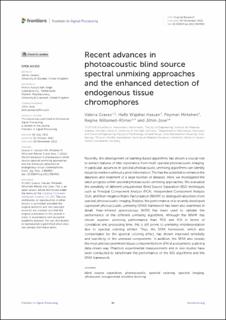| dc.contributor.author | Grasso, Valeria | |
| dc.contributor.author | Hassan, Hafiz Wajahat | |
| dc.contributor.author | Mirtaheri, Peyman | |
| dc.contributor.author | Willumeit-Römer, Regine | |
| dc.contributor.author | Jose, Jithin | |
| dc.date.accessioned | 2023-02-23T11:42:02Z | |
| dc.date.available | 2023-02-23T11:42:02Z | |
| dc.date.created | 2022-11-16T04:57:14Z | |
| dc.date.issued | 2022 | |
| dc.identifier.citation | Frontiers in Signal Processing. 2022, . | en_US |
| dc.identifier.issn | 2673-8198 | |
| dc.identifier.uri | https://hdl.handle.net/11250/3053576 | |
| dc.description.abstract | Recently, the development of learning-based algorithms has shown a crucial role to extract features of vital importance from multi-spectral photoacoustic imaging. In particular, advances in spectral photoacoustic unmixing algorithms can identify tissue biomarkers without a priori information. This has the potential to enhance the diagnosis and treatment of a large number of diseases. Here, we investigated the latest progress within spectral photoacoustic unmixing approaches. We evaluated the sensitivity of different unsupervised Blind Source Separation (BSS) techniques such as Principal Component Analysis (PCA), Independent Component Analysis (ICA), and Non-negative Matrix Factorization (NNMF) to distinguish absorbers from spectral photoacoustic imaging. Besides, the performance of a recently developed superpixel photoacoustic unmixing (SPAX) framework has been also examined in detail. Near-infrared spectroscopy (NIRS) has been used to validate the performance of the different unmixing algorithms. Although the NNMF has shown superior unmixing performance than PCA and ICA in terms of correlation and processing time, this is still prone to unmixing misinterpretation due to spectral coloring artifact. Thus, the SPAX framework, which also compensates for the spectral coloring effect, has shown improved sensitivity and specificity of the unmixed components. In addition, the SPAX also reveals the most and less prominent tissue components from sPAI at a volumetric scale in a data-driven way. Phantom experimental measurements and in vivo studies have been conducted to benchmark the performance of the BSS algorithms and the SPAX framework. | en_US |
| dc.language.iso | eng | en_US |
| dc.publisher | Frontiers Media | en_US |
| dc.relation.ispartofseries | Frontiers in Signal Processing;Volume 2 - 2022 | |
| dc.rights | Navngivelse 4.0 Internasjonal | * |
| dc.rights.uri | http://creativecommons.org/licenses/by/4.0/deed.no | * |
| dc.title | Recent advances in photoacoustic blind source spectral unmixing approaches and the enhanced detection of endogenous tissue chromophores | en_US |
| dc.type | Peer reviewed | en_US |
| dc.type | Journal article | en_US |
| dc.description.version | publishedVersion | en_US |
| dc.rights.holder | © 2022 Grasso, Hassan, Mirtaheri, Willumeit-Rӧmer and Jose | en_US |
| cristin.ispublished | true | |
| cristin.fulltext | original | |
| dc.identifier.doi | https://doi.org/10.3389/frsip.2022.984901 | |
| dc.identifier.cristin | 2074579 | |
| dc.source.journal | Frontiers in Signal Processing | en_US |
| dc.source.volume | 2 | en_US |
| dc.source.issue | 2 | en_US |
| dc.source.pagenumber | 1-17 | en_US |

